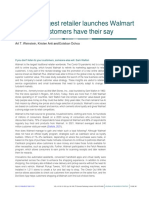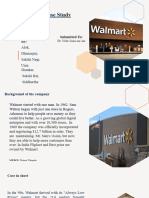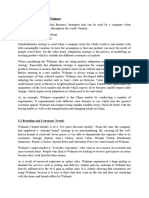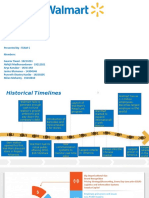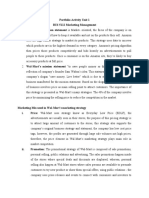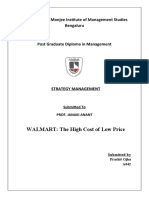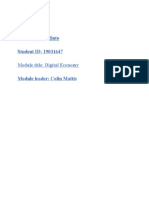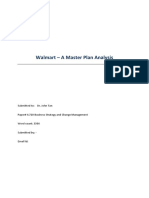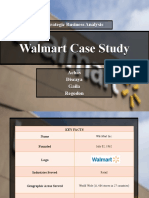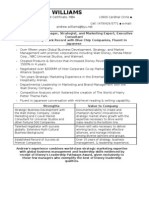1
Evaluating whether Walmart's marketing process and decisions are correct in the current
business climate.
Author
Institutional Affiliation
Course
Instructor’s Name
Date
1929 words
� 2
Introduction
Aims and Objectives of the Report
The main goal of this analysis is to assess how well Walmart Inc.'s marketing procedures
align with present-day global business standards. The study analyzes Walmart's marketing-led
methods while evaluating marketing obstacles alongside strategic instruments that might bolster
its market position.
Background Information about the Company
Walmart Inc. began its operations in 1962 as the world's largest multinational retail
corporation, maintaining its headquarters in Bentonville, Arkansas. It operates over 60 retail
brands through which it oversees hypermarkets, discount department stores, and grocery stores in
more than 24 countries worldwide (Buchdadi, 2024). Its brand represents cost-effective shopping
and optimized operations that support weekly transactions among millions of customers at its
stores and digital platforms. Walmart Inc. maintained its status as a leading retail organization
during times of digital transformation alongside rising inflation rates and changing customer
preferences throughout 2024.
Brief Research Plan
Resources like academic theories, case studies, industry insights, and recent corporate
data support this research. The effectiveness of Walmart's marketing strategies will be evaluated
� 3
through key marketing management frameworks SWOT and PESTLE and 7Ps and Porter's Five
Forces.
The Outside-In Approach
The Marketing-Led Approach
All business activities under the marketing-led approach start with identifying customer
needs, which leads organizations to fulfill consumer demands. The continuous collection of
market data allows organizations to modify their products specifically for customer needs, thus
establishing enduring customer loyalty and business success. Walmart has followed this model
since 2006 and intensified its adoption with a focus on offering convenient services at affordable
costs and digital interface access (Farida & Setiawan, 2022). Adopting services that include
curbside pickup, same-day delivery, and mobile app ordering has allowed Walmart to develop its
image as a company that serves customers quickly. It also leverages data analysis to track
customer buying patterns to enhance inventory placement and merchandise display while
ensuring product accessibility. Walmart's commitment to its customers has allowed it to maintain
competitiveness against rising e-commerce competitors like Amazon. On top of the customer
feedback loops it uses to make decisions, the company reflects a marketing-driven organizational
culture that promptly adjusts to changing market needs.
Comparison with Alternative Approaches
The outside-in marketing approach Walmart follows differs from three other business
strategy options known as product-led, sales-led, and production-led approaches, which present
different advantages and restrictions. The product-led approach centers its efforts on product
� 4
advancement and quality because improved products will draw customers by themselves.
Walmart's wide variety of affordable merchandise does not match its fundamental business
model well since its business strategy centers on providing affordable products while
maintaining wide availability instead of concentrating on elite product differentiation.
Business organizations that use a sales-led approach depend on intense promotional
activities and sales force to generate revenue growth (Ros, 2021). The promotional pricing at
Walmart creates advantages in sales, yet excessive focus on temporary price drops may damage
customer faith and lead to immediate earnings instead of steady customer commitment. The
company retains its alignment with cost leadership and supply-chain excellence through its
production-oriented approach focusing on operational efficiency and mass production. The
company risks facing market obsolescence because its model fails to adapt its preferences to
customer demands in environments that value personalized experiences. It benefits from keeping
essential elements of other approaches, but its customer-centered marketing strategy stands
strongest in meeting market needs and sustaining business success in the current retail landscape.
Marketing Issues
Current Marketing Issues Faced by Walmart
Walmart encounters multiple marketing hurdles within the fast-changing modern retail
environment. For instance, intense competition with e-commerce leaders such as Amazon drives
an urgent need for Walmart to face multiple marketing challenges because they have transformed
customer expectations regarding convenience, speed, and digital personalization (Zhang, 2024).
The company continues to advance its internet presence, yet it needs to resolve various
� 5
operational inconsistencies between its physical stores and digital platforms to enable
omnichannel excellence. Consumer preferences favoring sustainable sourcing and ethical
business practices are putting substantial pressure on Walmart to develop sustainable practices
while improving its brand identity. The aggressive market competition and demanding
preferences from digitally literate younger consumers represent an ongoing challenge for
Walmart to keep its customers committed (Weinstein, Anti, and Ochoa, 2021). On the other
hand, economic uncertainty creates price sensitivity obstacles for Walmart, which it needs to
manage between maintaining affordable prices and maintaining profitability. Effective resolution
of these problems depends on how well Walmart innovates its marketing approaches while
enhancing customer connections and clearly distinguishing its brand value.
Tackling the Issues
Walmart needs to develop further its digital transformation strategy to resolve its existing
marketing problems. The company must develop superior omnichannel capabilities to create a
smooth customer shopping experience through its digital and brick-and-mortar operations. The
company can enhance its market competition against e-commerce leaders by investing in
artificial intelligence for personalization, mobile application development, and last-mile delivery
system improvements (Durand and Baud, 2023). It should enhance the openness of its
sustainability initiatives by revealing details about eco-friendly product promotion and ethical
sourcing practices since younger consumers gravitate towards these values. Furthermore,
purpose-driven promotional strategies help forge emotional ties with customers, strengthening
brand loyalty and attracting socially active buyers. Evidence from research indicates that
Walmart should use price analytics to optimize inventory management but maintain its low
� 6
everyday prices to combat customer sensitivity to prices (Hao, 2024). A customer-focused
method that includes loyalty programs and personalized marketing coupled with responsive
customer service will allow Walmart to continue meeting contemporary consumer expectations
while maintaining its competitive advantages.
Strategies for Overcoming Marketing Issues
Walmart should implement solution strategy components centered on innovation for
product development and customer engagement alongside environmental sustainability
initiatives to address current marketing problems (Zhang, 2024b). The company must keep
advancing its omnichannel method through advanced analytics to deliver personalized
encounters across every platform. By introducing services such as immediate delivery options,
member subscriptions, and store pickup facilities, Walmart can bolster its customer experience
and satisfaction. It should also boost its digital advertising effectiveness through strategic social
media outreach and influential campaign cooperation to reach new consumer demographics,
including younger audiences, and gain better brand exposure.
Walmart needs sustainability to guide its entire strategic direction. Ethical sourcing
practices, sustainability initiatives, and decreases in plastic consumption can enable Walmart to
attract customers devoted to environmental conservation (Vadakkepatt et al., 2021). The
company should establish customer loyalty programs to benefit regular shoppers and stimulate
repeat purchasing behavior. Combining technology with customer-centric strategies can allow
Walmart to address its marketing challenges and sustain long-term success in the competitive
international market.
� 7
Marketing Management
Effectiveness of Marketing Management at Walmart
Walmart uses effective marketing management to sustain its global operations through
coordination. The management of marketing operations provides consistent methods for
branding and pricing and promoting and interacting with customers through different platforms
(Alam and Akter, 2025). Walmart maintains a central marketing structure that produces both
efficient operational choices and reduced costs. Organizing marketing by geographical regions
could help Walmart better meet specific consumer needs that differ according to cultural
preferences in target areas.
Useful Marketing Management Tools
Walmart should implement specific essential marketing management tools to enhance its
marketing performance. SWOT analysis is a vital tool because it enables the company to
determine its internal capabilities, market-facing opportunities, and potential threats. This
approach permits Walmart to create marketing strategies that match its organizational
capabilities while responding to market needs. The company requires Customer Relationship
Management (CRM) systems to track customer behavior for market segmentation and
personalized promotion delivery, which builds customer retention (Cao, 2021). The 4Ps
marketing mix provides Walmart a strategic approach to achieve value through product
development while maintaining affordable pricing in their price-sensitive market. The
assessment of competitive dynamics through Porter's Five Forces enables Walmart to design
� 8
strategies that manage industry factors such as supplier and buyer power alongside rival industry
competition and threats from substitute products. The integration of these tools through
Walmart's marketing management processes allows the company to base its decisions on data,
enhancing business expansion and efficient customer service.
Future Trends in Marketing
Application of Strategic Tools
To successfully face changes in the business environment, Walmart can implement
various strategic tools. Organizations use PESTLE analysis to detect external elements, including
marketplace economic transformations, technological changes, and regulatory adaptations that
affect marketing decision-making. Walmart's growth strategy will profit from Ansoff's Matrix by
revealing market penetration, product creation, and sector expansion paths. The BCG Matrix
enables Walmart to assess its product range and determine which categories require more
investment resources (Sushil and Dhir, 2024). The integration of these tools with Porter's Five
Forces enables Walmart to gain complete insight into competitive dynamics, which helps it
select strategic marketing choices that match future market trends while ensuring long-term
sustainability.
Anticipated Marketing Trends
Walmart needs to adapt to essential marketing trends to preserve its market
competitiveness in the upcoming years. The fundamental requirement of achieving customized
customer interactions throughout multiple platforms will rely on AI and data analysis systems.
Sustainability will play an ongoing role in the way consumers behave because environmental-
� 9
friendly product demand keeps increasing, making sustainability transparency a necessity to
remain the top organizational priority for the company. Social commerce growth, particularly on
TikTok, opens the possibility of reaching younger demographics (Islam et al., 2025). The
company will also face growing data privacy issues, compel it to use self-owned customer
information, and improve its customer relationship management efforts to build more reliable
customer relationships for targeted advertising.
Strategic Choices and Actions
Improving Walmart's omnichannel operations must become a priority because this
initiative will unify online shopping with store purchasing experiences. The environmental-
conscious customer base will connect with Walmart through expanded sustainability programs
encompassing eco-friendly product selection and enhanced supply chain performance. The
company should also invest in social commerce by using Instagram and TikTok to target
younger customers. The company can also enhance its marketing operations by implementing AI
systems that generate particular targeted promotions for each customer. Using first-party data to
prioritize privacy concerns helps Walmart comply with evolving regulations while building more
loyal customers who trust the company.
Conclusion
The marketing activities of Walmart Inc. show precise alignment with the principles of
marketing management as an organization-led approach. Walmart Inc. has reacted successfully
to updated market conditions through digital system implementation and service enhancement
while keeping consumer costs affordable. However, the company faces multiple obstacles,
� 10
including maintaining digital superiority, transforming its brand reputation, and handling
sustainability requirements. Through effective marketing management and strategic tools,
Walmart demonstrates readiness to adapt successfully to the future retail environment.
Recommendations
Walmart should employ the following recommendations to keep its competitive position
strong while handling existing challenges: The Company should advance its omnichannel
strategy through technology investments that connect online shopping to physical stores and
improve digital retail. Walmart should expand delivery possibilities and provide personalized
customer treatment to increase customer satisfaction and convenience. Walmart should intensify
its sustainability drive by delivering higher quantities of environmentally friendly items,
enhancing waste minimization techniques, and disclosing complete information about its supply
chain networks. The market places greater importance on companies following ethical business
standards to meet the evolving consumer requirements. Walmart needs to intensify its social
media activities through TikTok and Instagram because these platforms connect the company to
younger, digitally native customers. The company should produce engaging content and partner
with influencers to boost brand visibility and drive sales. The strategic use of artificial
intelligence combined with first-party consumer information allows Walmart to create
personalized promotions for better customer loyalty alongside complaints to privacy statutes.
� 11
Reference list
Alam , F. and Akter, T. (2025). Leadership Evaluation and Strategy Effectiveness: A Case Study
of Walmart Canada’s Store Manager. [online] Sagepub.com. Available at:
https://sk.sagepub.com/cases/skpromo/g6P1jT/leadership-evaluation-and-strategy-
effectiveness-a-case-study.
Buchdadi, A. D. (2024). Segmenting Walmart Customers for Personalized Marketing Strategies
Using MiniBatchKMeans Clustering and Decision Trees: An Analysis of Purchasing
Behavior. Journal of Digital Market and Digital Currency, 1(3), 204-224.
Cao, P. (2021). Big Data in Customer Acquisition and Retention for eCommerce – Taking
Walmart as an Example. Proceedings of the 2021 3rd International Conference on
Economic Management and Cultural Industry (ICEMCI 2021), 203, pp.259–262.
doi:https://doi.org/10.2991/assehr.k.211209.043.
Durand, C. and Baud, C. (2023). Profit-making, costs, and investments in the digitalization of
retailing—The uneven trajectories of Carrefour, Amazon and Walmart (1995–2019).
Competition and Change, 28(2), pp.318–339.
doi:https://doi.org/10.1177/10245294231204973.
Farida, I., & Setiawan, D. (2022). Business strategies and competitive advantage: the role of
performance and innovation. Journal of Open Innovation: Technology, Market, and
Complexity, 8(3), 163.
Hao, R. (2024). Streamlining SCM: Integrating Demand Forecasting and Inventory
Optimization. Advances in economics, business and management research/Advances in
Economics, Business and Management Research, [online] pp.550–558.
doi:https://doi.org/10.2991/978-94-6463-542-3_63.
Islam, R., Kazi, N., Asif, M., None Farhan Nasrullah, None Nayeema Nusrat, None Shamina
Sharmin Jishan and Ahmed, N.S. (2025). How Digital Marketing Affiliates the Digital
Stores: A Deep Dive into Shopify, Amazon, Walmart, and Other E-Commerce Giants.
� 12
Journal of Computer Science and Technology Studies, 7(2), pp.95–101.
doi:https://doi.org/10.32996/jcsts.2025.7.2.8.
Ros, R. (2021). Continuous Experimentation with Product-Led Business Models: A Comparative
Case Study. Lecture Notes in Business Information Processing, pp.143–158.
doi:https://doi.org/10.1007/978-3-030-67292-8_11.
Sushil and Dhir, S. (2024). Strategy Formulation and Adaptation. Strategic Management,
pp.193–211. doi:https://doi.org/10.1007/978-981-97-4788-7_11.
Vadakkepatt, G.G., Winterich, K.P., Mittal, V., Zinn, W., Beitelspacher, L., Aloysius, J., Ginger,
J. and Reilman, J. (2021). Sustainable Retailing. Journal of Retailing, [online] 97(1),
pp.62–80. doi:https://doi.org/10.1016/j.jretai.2020.10.008.
Weinstein, A.T., Anti, K. and Ochoa, E. (2021). World’s biggest retailer launches Walmart Plus
and customers have their say. Journal of Business Strategy, [online] 43(6).
doi:https://doi.org/10.1108/jbs-07-2021-0133.
Zhang, W. (2024a). An Analysis of Walmart Based on Its Internal and External Environment.
Advances in economics, management and political sciences, 77(1), pp.142–147.
doi:https://doi.org/10.54254/2754-1169/77/20241609.
Zhang, W. (2024b). An Analysis of Walmart Based on Its Internal and External Environment.
Advances in economics, management and political sciences, 77(1), pp.142–147.
doi:https://doi.org/10.54254/2754-1169/77/20241609.










